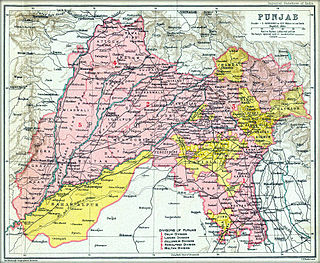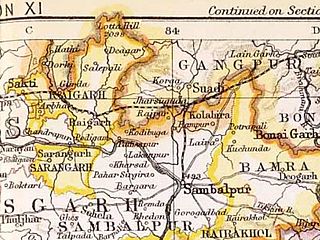Bilaspur is a town and a municipal council in Bilaspur district in the Indian state of Himachal Pradesh.

Bushahr, also spelt as 'Bashahr' and 'Bussahir' or 'Bushair' was a Rajput princely state in India during the British Raj. It was located in the hilly western Himalaya promontory bordering Tibet in the northern part of colonial Punjab region.
The Hill States of India were princely states lying in the northern border regions of the British Indian Empire.

Bilaspur State or Kahlur State, sometimes Kahloor Riyasat, was a kingdom (697-1849) and later princely state (1849-1948) in the Punjab Province ruled by a separate branch of Chandravanshi Chandel dynasty. Raja Bir Chand 697-730 was the founder of the state but it was named Kahlur only after the Construction of Kahlur Fort by Raja Kahal Chand around 890-930CE and Raja Anand Chand the 44th Raja was the last ruler.
Keonthal State, covering an area of 482 km2, was one of the Princely states of India during the period of the British Raj. Its capital was Junga. Keonthal acceded to India on 15 April 1948. Currently, it is part of the Indian state of Himachal Pradesh.

The Punjab States Agency was an agency of the British Raj. The agency was created in 1921, on the model of the Central India Agency and Rajputana Agency, and dealt with forty princely states in northwest India formerly dealt with by the Province of Punjab.

The Kangra Fort is located 20 kilometers from the town of Dharamsala on the outskirts of the town of Kangra, in the Kangra district of Himachal Pradesh, India.
Chenani is a town and tehsil in the Udhampur district, in the Indian union territory of Jammu and Kashmir. It is governed by a notified area council. Before 1947, it was an internal jagir ruled by a Chandel (Rajput) ruler in the princely state of Jammu and Kashmir. This Town has further gained importance after getting the Asia's longest tunnel from chenani to nasari.

Dhami was a Princely State situated 26 kilometres (16 mi) west of Shimla, India. Its capital was Halog and the state formed a part of the region known as the Punjab Hill States Agency during the British Raj period. In 1941 it had an area of 73 square kilometres (28 sq mi) and a population of 5,114 people. In 1948 Dhami was made a part of Himachal Pradesh.

Chamba State was one of the oldest princely states in present-day Republic of India, having been founded during the late 6th century. It was part of the States of the Punjab Hills of the Punjab Province of British India from 1859 to 1947. Its last ruler signed the accession to the Indian Union of 15 April 1948.

Sakti State was one of the princely states of India during the British Raj. It belonged to the Chhattisgarh States Agency, which later became the Eastern States Agency.
Siokot was a state in India that preceded the princely state of Mandi, which was founded in 1527. Formerly part of the Kingdom of Suket in the Punjab Hills, the rajput dynasty traditionally goes back to 765 AD. In about 1100, Vijaya Sen had two sons, Sahu Sen who ruled over Suket and Bahu Sen who ruled over Kullu. Bahu Sen’s descendants emigrated to Kullu until the tenth descendant, Kabakha Sen was killed by the Raja of Kullu and his son had to flee to Siokot, not very far from the present city of Mandi, Himachal Pradesh, which was founded during Ajbar Sen’s rule.

Mandi State was a native state of British India, within the Punjab; with Mandi, Himachal Pradesh as its capital. The state of Mandi, which included two towns and 3,625 villages, was part of the States of the Punjab Hills. It was located in the Himalayan range, bordering to the west, north, and east on the British Punjabi district of Kangra; to the south, on Suket; and to the southwest, on Bilaspur. As of 1941, population of Mandi State was 232,598 and area of the state was 1,139 square kilometres (440 sq mi).

Kutlehar State, covering an area of 2,200 km2 (850 sq mi), was one of the Princely states of India.They were originally Kshatriyas.

Suket State was one of the Princely states of India during the period of the British Raj. The capital of the state was Pangna. Its last ruler signed the accession to the Indian Union on 15 April 1948. Formerly it belonged to the States of the Punjab Hills and currently, it is part of the Indian state of Himachal Pradesh. The present-day Mandi district was formed with the merger of the two princely states of Mandi and Suket.
His Highness Raja Sir Anand Chand was the 44th Raja of Bilaspur. He was a Member of Parliament, representing Bihar in the Rajya Sabha, the upper house of India's Parliament as a member of the Indian National Congress.
Dadwal, also written as Dadhwal and Dhadwal, is a surname prevalent in Punjab, Himachal Pradesh and Jammu.
Jubbal State was a non-salute state of the Simla Hill States Superintendency of the Punjab States Agency. Thought to have been founded in the twelfth century, it merged with the Indian Union in 1948.









